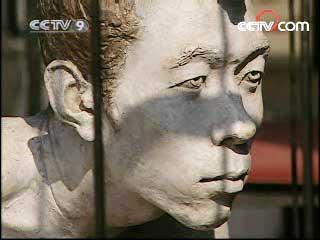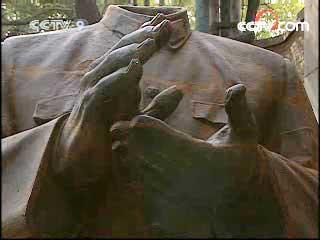------Program code: DO-080319-01688 (what's this?)
Source: CCTV.com
03-19-2008 09:01
Every evening the staff carry the sculptures into the gallery, and every morning they return them to their cages. The sculptures and their images face each other for the whole day. This is the routine at 798.
 |
The train laden with coal is arriving at its final stop. 50 years ago, this was the North China Wireless Components Friendship Factory, known by the code, 718. One of the five plants under it was the famous 798. In the 1950s, these plants, all with code numbers beginning with a "7", formed a key military-industrial complex in the eastern suburbs of Beijing.
"7" signified the electronics industry. 50 years later, once-secret plants such as 718 and 706 have been reformed and belong to group companies bearing names characteristic of the new era. Only 798 remains the exception.
The graffiti-covered wall used to enclose 798's garage. In the dictionary, "graffiti" is defined as casual writing or drawing on a public wall. Since it first appeared in US subways in the 1960s, this form of art has generally been an expression of rebellion and non-conformity.
Zhu Yan, Photographer, said, "It included the chemical warehouse in front. You had to telephone to pass the security. The warehouses have been demolished and it's more spacious inside. The security checkpoint was here. Entrance was permitted by phone call only."
Zhu Yan knew 798 very well, because he took many pictures of it.
The numerical code names indicated secret military plants. In the 1950s, these German-designed factories were responsible for the largest scale military production in China.
The original designers and builders could never have imagined 798 as it is half a century later. As a centre of modern art, its previous role as a military factory has been eclipsed. 798 is no longer an industrial code, but a cultural code. Repeated appearances in the media have turned it into a cultural icon. For the youth of today, 798 is a symbol of art, of being cool and avant-garde. But the fame of 798 extends even further, and it also symbolizes the old electronic enterprises that surround it.
 |
Huang Rui, Artist, said, "798 represents the aspiration for beauty. It is attractive, and captivated me at first sight."
Huang Rui was among the first artists to move into 798. Following her, more and more freelance artists arrived. None had anything to do with the electronics industry. Zhu Yan, a photographer, produced a series of portraits of 80 people. Each is marked by the calm air of someone who feels at home.
Zhu Yan said, "Plants like 798 were usually built on farmland. The farmers' land was turned over to the incoming workers. Then artists took over from the workers, and they may be followed by somebody else. That's the way it is."
Be they farmers, workers or artists, they all have their aspirations.
